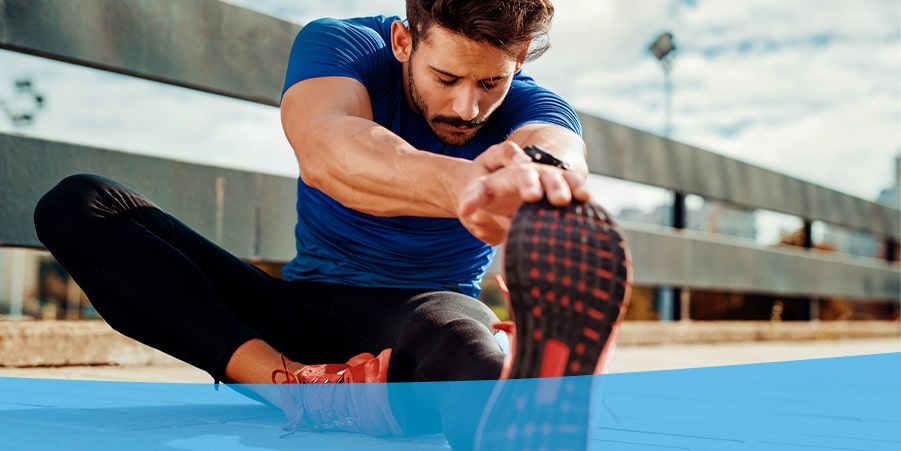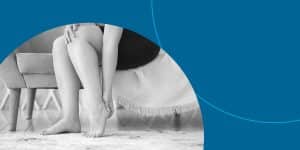The Importance of Stretching in Reducing Exercise-Induced Foot and Ankle Injuries
Foot and ankle injuries are common for seasoned athletes and those who enjoy recreational exercises. Overlooking proper warmup, cool-down and stretching practices further increases the risk of injury. Fortunately, with a proper routine, you can minimize the risk of strains or sprains.
The Importance of Warmup, Cool Down and Stretching
We often think of stretching as a way to make our muscles more flexible, but its benefits go beyond that. Stretching, warming up before exercise and cooling down afterward can reduce foot and ankle injuries. Here’s why it’s important to include all three practices in your routine:
Warming Up
Warming up prepares your muscles for movements they’re about to perform. This is particularly true for your feet and ankles, which are involved in running, jumping and strength training. The process increases blood flow, improves flexibility and enhances joint mobility to reduce injury.
Dynamic stretches, like ankle circles, are excellent ways to prepare for exercise. They ensure your joints are lubricated and your muscles are primed for the work ahead.
Cool Down
A proper cool-down gradually brings your heart rate back to its resting state, reduces the risk of lightheadedness or dizziness and may improve flexibility and injury reduction. Progressively lowering your heart rate helps normalize blood pressure and restore circulation to preexisting levels.
During exercise, your body’s production of lactic acid increases, accumulating in your muscle tissue. Lactic acid fuels your body during workouts, but excess can cause muscle cramps, so stretching helps the body clear the by-product.
In addition to clearing lactic acid, cooling down can reduce the severity of delayed onset muscle soreness (DOMS). DOMS is characterized by microtears in muscle fibers that occur during intense or unfamiliar exercise. The soreness is part of the healing process, as your body repairs these microtears to strengthen muscles.
Common symptoms of DOMS include:
- Muscle pain or soreness, typically starting 12-24 hours after exercise.
- Soreness that peaks around 24-72 hours post-exercise.
- Tenderness to the touch.
- Swelling in the affected areas.
- Reduced range of motion.
- Mild weakness or difficulty using the affected muscle group.
Although DOMS typically resolves itself, gentle stretches can improve blood circulation, encourage muscle relaxation and support recovery. Medical attention may be necessary if you experience intense pain, severe swelling or dark-colored urine.
What Types of Foot and Ankle Injuries Can Occur Without Proper Stretching?
Improper or insufficient stretching can make your feet and ankles more vulnerable to various injuries. The most common ones include:
Sprained Ankle
A sprain occurs when the ligaments in the ankle are overstretched or torn, usually from a sudden twist or awkward landing. Ankle sprains can happen to anyone, but they’re more common among athletes because the joint bears much of the body’s weight during movement. Without proper warmup or stretching, the ankle is at risk of sudden overextension or uncomfortable positioning, making the ligaments more prone to injury.
Signs and symptoms of a sprain include:
- Swelling and bruising around the ankle joint.
- Pain when bearing weight on the foot.
- Limited range of motion.
- Tenderness to the touch.
Achilles Tendinitis
Achilles tendinitis happens when the Achilles tendon, connecting the calf muscles to the heel bone, becomes inflamed from excessive strain. This condition is often triggered by sudden increases in physical activity and insufficient stretching or warmup, leading to stiffness and pain above the heel. Left untreated, it can lead to an Achilles tendon rupture.
Symptoms of Achilles tendinitis include:
- Stiffness and tenderness in the calf muscle.
- Swelling or warmth around the tendon.
- Pain that worsens with activity.
Stretching the tendons before and after exercise to increase flexibility is one way to minimize the risk of Achilles tendinitis.
Plantar Fascitis
Plantar fasciitis is an overuse injury that occurs when the plantar fascia, a wide strap of tissue running along the bottom of the foot, becomes inflamed. This condition often results from repetitive strain on the foot arch, causing the tissue to tighten and increasing the risk of inflammation.
Common symptoms of plantar fasciitis include:
- Sharp or stabbing pain in the affected area.
- Stiffness.
- Tight or tense Achilles tendon.
- Pain that worsens after exercise.
- Pain in the foot’s arch.
Stretching may help improve flexibility and reduce the tension on the fascia during exercise.
Stress Fractures
Stress fractures are small cracks in the bone caused by overuse, which typically occur in the metatarsal bones of the foot. They are common in runners and athletes who subject their feet to repetitive pounding without adequate recovery time for their muscles and bones.
Symptoms of a stress fracture include:
- Pain in the affected area that worsens with activity.
- Tenderness and swelling at the fracture site.
- Pain that intensifies at rest.
Proper foot and lower leg stretching can prevent the condition by helping maintain foot and ankle alignment.
How to Properly Stretch Your Feet and Ankles
Properly stretching your feet and ankles involves two main types of stretching:
1. Dynamic Stretches
Dynamic stretching consists of controlled, flowing movements that help improve muscle activation, joint mobility and circulation. These stretches gradually elevate your heart rate, prepare your muscles for exercise and reduce the risk of injury. Here are some dynamic stretches that target the feet and ankles:
- Ankle circles: Sit in a sturdy chair with a straight back and feet flat on the ground. Raise one foot off the floor, keeping the other planted for balance. Your raised leg should be extended out slightly but relaxed. Slowly rotate your lifted ankle in a circular motion. Start with 10 rotations in a clockwise direction. Switch and perform 10 counterclockwise circles.
- Heel-to-toe walk: Stand tall with feet shoulder-width apart and arms relaxed at your sides. Take a step forward by placing your right heel on the ground first, then slowly roll your foot forward until your toes touch the ground. As you shift your weight to your right foot forward, bring your left foot forward. Place the heel down first, followed by the rest of the foot, so it touches the ground heel-to-toe. Continue walking for 30-60 seconds.
2. Static Stretches
Static stretches involve holding a position for a certain duration to lengthen and relax the muscles. They promote flexibility and improve range of motion at specific joints and are often performed post-workout. Here are a couple of examples:
- Seated toe reach: Sit on the ground with your legs extended straight in front of you, feet together. Reach forward with both hands toward your toes. If you can’t reach your toes, aim for your ankles or shins. Once you feel a gentle stretch in your hamstrings and calves, hold this position for 15-30 seconds. Return to your starting position and repeat two or three times.
- Heel drop: Stand on a stepladder or sturdy elevated surface with the balls of your feet on the edge and your heels hanging off the back. Slowly lower your heels toward the ground by gently bending your ankles. You should feel a stretch in your Achilles tendon and calf muscles. Maintain this lowered position for 15-30 seconds, breathing deeply and relaxing into the stretch. Gently raise your heels back to the starting position. Repeat two or three times.
Contact a Podiatrist at Foot & Ankle Surgical Associates
If you’re dealing with a foot or ankle injury, Foot & Ankle Surgical Associates is here to help. With state-of-the-art technology at our surgical center and a team of specialists dedicated to your recovery, we provide expert diagnosis and treatment for various concerns.
We also offer personalized physical therapy services to aid in your rehabilitation. Our Olympia clinic is open on Saturdays for your convenience, and we offer same-day or next-day appointments. Additionally, we accept all major insurance plans to ensure you get the care you need when you need it. Book an appointment today.
Linked sources:
- https://fasafw.com/blog/common-foot-and-ankle-ailments-we-treat-in-office/
- https://www.heart.org/en/healthy-living/fitness/fitness-basics/warm-up-cool-down
- https://www.health.harvard.edu/staying-healthy/take-that-muscle-cramps#
- https://pmc.ncbi.nlm.nih.gov/articles/PMC11012564/
- https://pmc.ncbi.nlm.nih.gov/articles/PMC10769056/
- https://www.acsm.org/docs/default-source/files-for-resource-library/delayed-onset-muscle-soreness-(doms).pdf?sfvrsn=8f430e18_2
- https://fasafw.com/blog/home-remedies-for-ankle-pain/
- https://www.bcm.edu/news/common-olympic-injuries
- https://medlineplus.gov/sportsinjuries.html
- https://fasafw.com/blog/what-to-know-about-achilles-tendon-injuries/
- https://orthoinfo.aaos.org/en/diseases–conditions/sprained-ankle/
- https://orthoinfo.aaos.org/en/diseases–conditions/achilles-tendinitis/
- https://medlineplus.gov/ency/imagepages/19567.htm
- https://fasafw.com/blog/difference-between-a-sprain-strain-and-tear/
- https://www.ncbi.nlm.nih.gov/books/NBK532289/
- https://fasafw.com/blog/stress-fracture-vs-regular-fractures/
- https://pmc.ncbi.nlm.nih.gov/articles/PMC11027948/
- https://nptiflorida.edu/the-science-of-stretching/
- https://acthealth.org/adding-static-stretching-to-your-workout-routine/
- https://resources.specialolympics.org/sports-essentials/sports-and-coaching/warm-up-and-cool-down-videos/dynamic-warm-up-calf-raises
- https://fasafw.com/foot-ankle/foot-ankle-surgery-centers/




